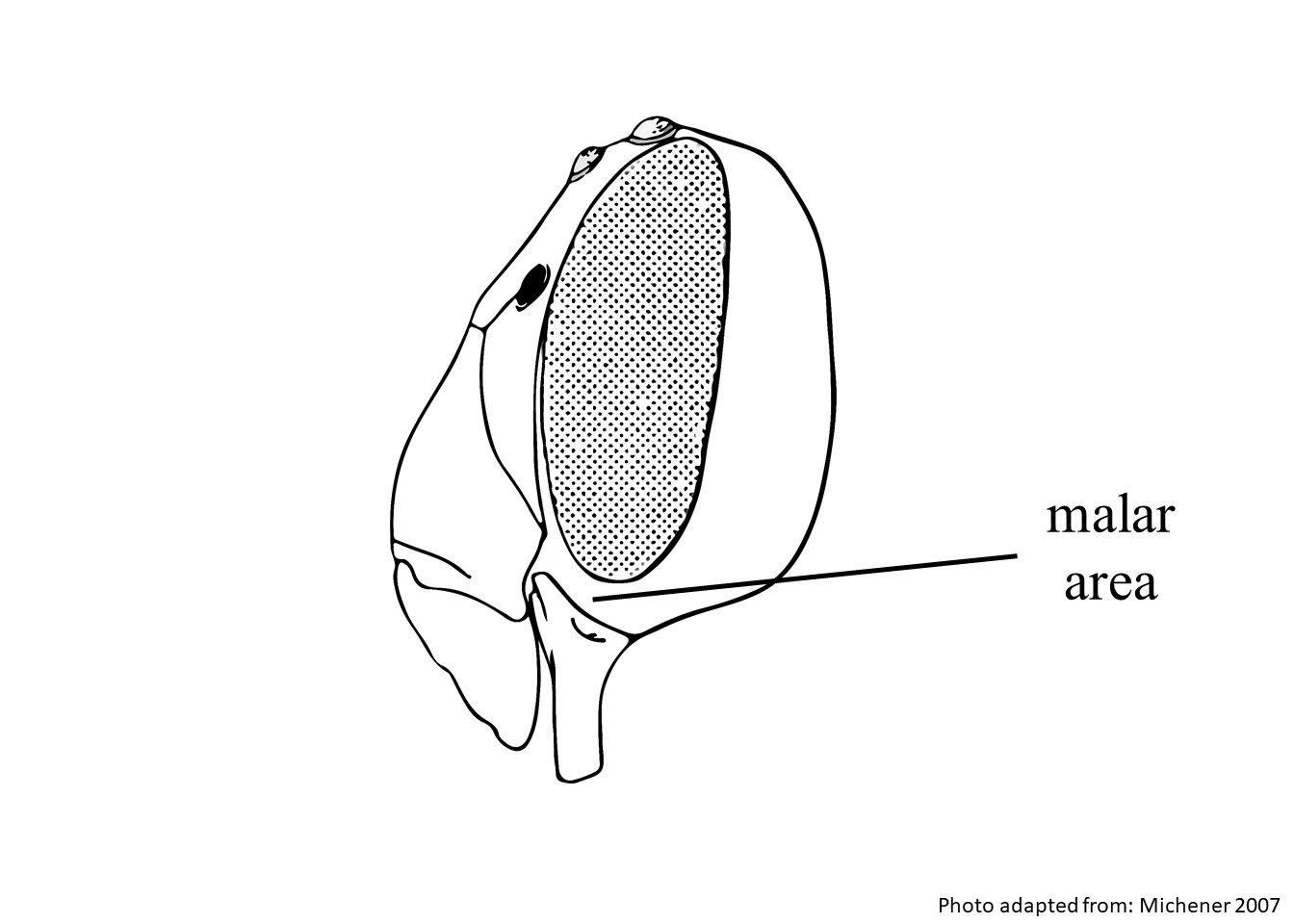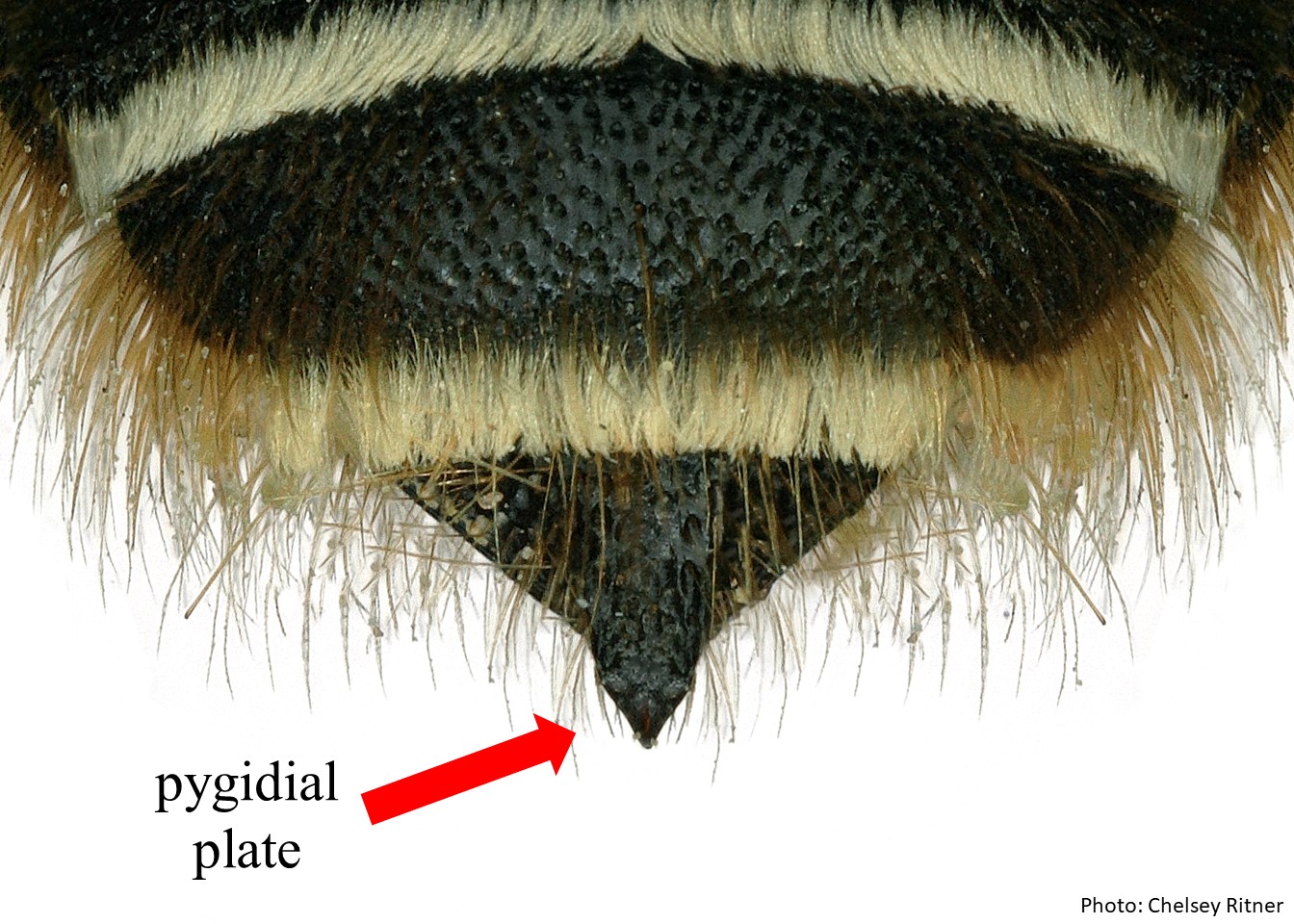Xylocopa (Diaxylocopa) is known only by the female of one species, Xylocopa truxali. It is a small bee, 10 – 15 mm in length, which has black integumentintegument:
a tough, protective outer layer
with very weak metallic reflections. It has a moderate to thick brownish black pubescencepubescence:
short, fine hair
on the head, thorax, and the underside of the abdomen that is slightly lighter on the dorsumdorsum:
in general, the upper surface
of the thorax. They also have brownish orange hair on the pygidialpygidial:
the terminal part or hind segment of the body
fimbria and white laterallateral:
relating, pertaining, or attached to the side
tufts on the last two tergaterga:
the segments on the top side of the abdomen, often abbreviated when referring to a specific segment to T1, T2, T3, T4, T5, T6, or T7 . The wings are brown with weak violet iridescence (Hurd and Moure 1963Hurd and Moure 1963:
. The wings are brown with weak violet iridescence (Hurd and Moure 1963Hurd and Moure 1963:
Hurd, P.D. and J.S. Moure. 1963. A Classification of the Large Carpenter Bees (Xylocopine) (Hymenoptera: Apoidea). University of California Publications in Entomology (Vol. 29). Berkeley and Los Angeles: University of California Press, 365 pp.). Xylocopa truxali is considered to be a threatened species because of habitat destruction (Martins et al. 2012Martins et al. 2012:
Martins, C., R. A. Silveira, N. d. O. Nascimento, and Y. Antonini. 2012. Fauna de abelhas de campos rupestres ferruginosos no Quadrilaacute;tero Ferriacute;fero, Minas Gerais. Biota 5: 34-37.).
Xylocopa (Diaxylocopa) contains only one listed species, Xylocopa truxali (Hurd and Moure 1963Hurd and Moure 1963:
Hurd, P.D. and J.S. Moure. 1963. A Classification of the Large Carpenter Bees (Xylocopine) (Hymenoptera: Apoidea). University of California Publications in Entomology (Vol. 29). Berkeley and Los Angeles: University of California Press, 365 pp.).
Few Xylocopa (Diaxylocopa) have been collected so little is known about their floral preferences but they are known to excavate nests in the branches of Vellozia (Silveira 2002Silveira 2002:
Silveira, F. A. 2002. The bamboo-nesting carpenter bee, Xylocopa ( Stenoxylocopa ) artifex Smith (Hymenoptera: Apidae), also nests in fibrous branches of Vellozia (Velloziaceae). Lundiana International Journal of Biodiversity 3 (1): 953 pp.).
Distribution map generated by Discover Life -- click on map for details, credits, and terms of use.
Few Xylocopa (Diaxylocopa) have been collected so little is known about their floral preferences but they are known to excavate nests in the branches of Vellozia (Silveira 2002Silveira 2002:
Silveira, F. A. 2002. The bamboo-nesting carpenter bee, Xylocopa ( Stenoxylocopa ) artifex Smith (Hymenoptera: Apidae), also nests in fibrous branches of Vellozia (Velloziaceae). Lundiana International Journal of Biodiversity 3 (1): 953 pp.).
(modified from Hurd and Moure 1963Hurd and Moure 1963:
Hurd, P.D. and J.S. Moure. 1963. A Classification of the Large Carpenter Bees (Xylocopine) (Hymenoptera: Apoidea). University of California Publications in Entomology (Vol. 29). Berkeley and Los Angeles: University of California Press, 365 pp.)
 short.
short. narrow, with subapicalsubapical:
narrow, with subapicalsubapical:Xylocopa (Diaxylocopa) females are most similar to X. (Monoxylocopa) but can be easily differentiated by their tridentatetridentate:
having three teeth
mandibles.
Xylocopa (Diaxylocopa) has been reported to bore out nests in the branches of the plant genus Vellozia (Velloziaceae) (Silveira 2002Silveira 2002:
Silveira, F. A. 2002. The bamboo-nesting carpenter bee, Xylocopa ( Stenoxylocopa ) artifex Smith (Hymenoptera: Apidae), also nests in fibrous branches of Vellozia (Velloziaceae). Lundiana International Journal of Biodiversity 3 (1): 953 pp.).
There are no known invasives.
Hurd, P.D. and J.S. Moure. 1963. A Classification of the Large Carpenter Bees (Xylocopine) (Hymenoptera: Apoidea). University of California Publications in Entomology (Vol. 29). Berkeley and Los Angeles: University of California Press, 365 pp.
Martins, C., R. A. Silveira, N. d. O. Nascimento, and Y. Antonini. 2012. Fauna de abelhas de campos rupestres ferruginosos no Quadrilátero Ferrífero, Minas Gerais. Biota 5: 34-37.
Michener, C.D. 2007. The Bees of the World (2nd ed.). Johns Hopkins University Press, Baltimore and London, 953 pp.
Silveira, F. A. 2002. The bamboo-nesting carpenter bee, Xylocopa (Stenoxylocopa) artifex Smith (Hymenoptera: Apidae), also nests in fibrous branches of Vellozia (Velloziaceae). Lundiana International Journal of Biodiversity 3 (1): 953 pp.